
Original Link: https://www.anandtech.com/show/1569
FIRST LOOK: SiS 755FX for Socket 939 Athlon 64
by Wesley Fink on December 16, 2004 12:05 AM EST- Posted in
- Motherboards
About a year ago, we were very impressed with the introduction of the SiS 755 chipset. In fact, we were so impressed that we awarded our Editor's Choice for Best Athlon 64 chipset to SiS in SiS755 Reference Board: Athlon64 from SiS. We fully expected that many of the major motherboard manufacturers would be producing boards based on the SiS 755, but that never happened. In the end, only 2 SiS 755 motherboards made it to the AnandTech labs - an ECS and a Foxconn. Both were capable budget motherboards, but neither packed the kind of enthusiast features we hoped that we would see with the 755 chipset.
Now, a year later, we are taking a first look at an update to the SiS chipset called the 755FX. The FX adds support for the latest Socket 939, dual-channel memory, and 1000 HyperTransport, but it is otherwise quite similar to the 755. This is mainly due to the fact that the Winfast 755FXK8AA uses the same 964 Southbridge that we reviewed late last year. Winfast is the brand name used by Foxconn for their Athlon 64 motherboards.
The focus with the Winfast board is really value. Foxconn tells us that the Winfast 755FX will sell for less than $100, which will be the first Socket 939 board to reach that price point. If the Winfast 755FXK8AA is a decent performer, this will open new price points for Socket 939 systems - particularly those built around the new 3000+ and 3200+ 90nm value Athlon 64s.
SiS 755FX Chipset
The SiS 755 chipset was covered in detail in our review of the SiS 755 Reference board. The SiS 755 supported 800HT, Socket754, and single-channel memory. The 755FX takes the excellent features and performance of that chipset and updates it for Socket 939.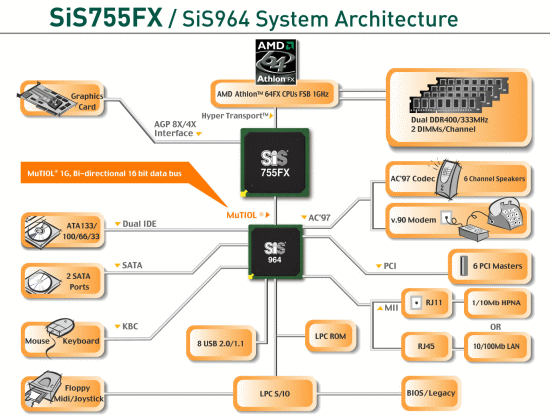
This means that the new 755FX supports 1000 HyperTransport speed, Socket 939, and dual-channel memory. Winfast combines the 755FX with the same 964 Southbridge used on the 755 Reference board. That means that this combination supports AGP8X, PCI, 4 IDE devices, and 2 native SATA ports.
| Model | Athlon 64FX Athlon 64 (939) |
Athlon 64FX Athlon 64 (939) |
Athlon 64 (754) |
| Pin Count | 939 | 939 | 754 |
| Memory Controller | Dual Channel DDR | Dual Channel DDR | Single Channel DDR |
| Memory Type | Unbuffered DDR400/333 | Unbuffered DDR400/333 | Unbuffered DDR400/333 |
| HyperTransport | 2000MT/s 8.0GB/s |
2000MT/s 8.0GB/s |
1600MT/s 6.4GB/s |
| Chipset | SiS756/965 | SiS755FX/964 | SiS755/964 |
| Graphic Interface | PCI-EXP x16 | AGP8X | AGP8X |
SiS has also announced a PCI Express chipset for Athlon 64, called the SiS 756. We have not seen a SiS 756 board yet, but the chipset specifications are basically the same as 755FX with support for PCI Express instead of AGP/PCI. The new 965 Southbridge announced with the 756 also supports 4 SATA 150 ports instead of the 2 SATA ports supported by 755/755FX.
Basic Features: Winfast 755FXK8AA
| Winfast 755FXK8AA Specifications | |
| CPU Interface | Socket 939 Athlon 64 |
| Chipset | SiS 755FX Northbridge - SiS 964 Southbridge |
| BUS Speeds | 200MHz to 350MHz in 1MHz Increments |
| PCI/AGP | Fixed at 33/66 |
| Core Voltage | Default, -0.1V, -.075V, -.05V, -.025V, -0.1V, +.025V, +.05V |
| CPU Clock Multiplier | Default, 4x-25x in 1X increments |
| HyperTransport Frequency | 1000MHz (1GHz) |
| HyperTransport Multiplier | 1X, 2X, 3X, 4X, 5X |
| DRAM Voltage | NO Adjustments |
| HyperTransport Voltage | NO Adjustments |
| Memory Slots | Four 184-pin DDR DIMM Slots Dual-Channel Configuration Regular Unbuffered Memory to 4GB Total |
| Expansion Slots | 1 AGP 8X 5 PCI Slots |
| Onboard SATA/SATA RAID | 2 SATA Drives by SiS964 (RAID 0, 1, JBOD) PLUS 2 SATA by Sil3112A (RAID 0, 1) |
| Onboard IDE/IDE RAID | Two Standard ATA133/100/66 (4 drives) |
| Onboard USB 2.0/IEEE-1394 | 8 USB 2.0 ports supported by SiS964 2 Firewire 1394a by Agere |
| Onboard LAN | Gigabit PCI LAN by Realtek 8110S-32 |
| Onboard Audio | AC '97 2.3 8-Channel by Realtek ALC850 |
| BIOS Revision | Award 11/20/2004 |
The Foxconn BIOS provides a wide range of BIOS control options, particularly considering Foxconn's history of very limited overclocking controls. The only notable omission is the lack of any memory voltage adjustments at all. Foxconn tells us that future board designs will provide for memory voltage control, but memory voltage is not adjustable on the 755FXK8AA.
It is nice to see Gigabit LAN, the 8-channel Realtek LAC850 audio, CPU ratios, HT ratios, and even Firewire on a board designed to sell for such a low price. If Foxconn could just do a bit more to satisfy the enthusiast, this would likely be a top-selling Socket 939 motherboard.
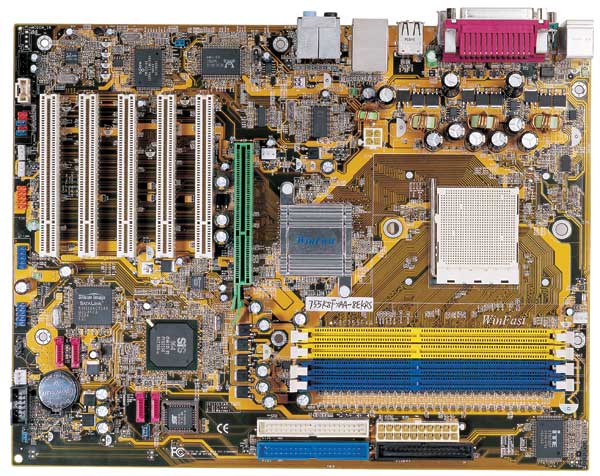
Boards designed for value often take short cuts in board design to minimize costs. However, no one will accuse Foxconn of that in the 755FXK8AA. The layout is generally excellent - much better than boards costing much more than the value priced Winfast. The 20-pin ATX is ideally located, and while the 4-pin 12V is between the CPU and rear IO, it is well clear of the CPU socket and HSF. IDE and floppy connectors are in our preferred upper right edge location, and IO headers are grouped along the bottom of the board where they will not interfere with slots.
The 4 memory slots are also well clear of the AGP 8X slot, so changing memory doesn't require removing a large AGP video card. The board is also a 3-phase design, instead of the 2-phase that we often see on boards designed to a price point. Frankly, if we had to guess the price of the Foxconn based on features, quality, and layout, we have guessed a higher price than this board actually sells for. This means that Foxconn/Winfast did a great job of providing more than you might expect in a board selling for less than $100.

The rear ports include 5 audio jacks, 4 USB, Firewire, SPDIF coaxial connector, parallel port. Gigabit LAN, serial port, and PS2 mouse/keyboard ports.
Overclocking: Winfast 755FXK8AA
| Front Side Bus Overclocking Testbed | |
| Default Voltage | |
| Processor: | Athlon 64 4000+ (2.4GHz, 1MB Cache) |
| CPU Voltage: | 1.50V (default 1.50V) |
| Cooling: | Thermaltake Silent Boost K8 Heatsink/Fan |
| Power Supply: | OCZ Power Stream 520W |
| Memory: | OCZ PC3200 EL Platinum Rev. 2 (Samsung TCCD Memory Chips) |
| Hard Drive: | Maxtor 160GB 7200RPM SATA 8MB Cache |
| Maximum OC: (Standard Ratio) |
221x12 (5x HT, 2-2-3-10) 2652MHz (+11%) |
| Maximum FSB: (Lower Ratio) |
233* x 11 (2563MHz) (5x HT) (1:1 Memory, 2 DIMMs in DC mode) (+17% Bus Overclock) |
At first, we were really excited that we could reach 300FSB with no vDIMM adjustments at all. However, several things did not make sense, and as we dug deeper, we discovered that the highest real speed we could achieve on the Winfast was 233 FSB. You can choose higher settings, but they are not real FSB overclocks. Foxconn did further testing on the 755FXK8AA and confirmed that the highest setting possible on this board is 233. Any higher settings would require an updated clock generator. Foxconn is looking at possible revisions to the Winfast, but 233 is the current OC limitation, and this will likely remain the case on this motherboard. Future redesigns of the board may bring additional FSB options.
It would be unfair to make too much of the 233 FSB limitation of the 755FX because that would overlook the incredible stability of the board at 233. At that overclock, the Winfast is completely stable. 233 is also a high enough overclock to confirm a working PCI/AGP lock. As you will see in the later performance data, the 755FXK8AA is very fast, so it makes you wish for more in the overclocking capabilities.
Memory Stress Testing
Our memory stress test measures the ability of the Winfast to operate at its officially supported memory frequency (400MHz DDR), at the lowest memory timings that OCZ PC3200 Platinum Rev. 2 modules will support. All DIMMs used for stress testing were 512MB double-sided (or double-bank) memory. To make sure memory performed properly in Dual-Channel mode, memory was only tested using either one dual-channel (2 DIMMs) or 2 dual-channels (4 DIMMs).| Stable DDR400 Timings - One Dual-Channel (2/4 DIMMs populated) |
|
| Clock Speed: | 200MHz |
| CAS Latency: | 2 |
| RAS to CAS Delay: | 2T |
| RAS Precharge: | 10* |
| Precharge Delay: | 2T |
| Command Rate: | 1T |
Using two DIMMs in Dual-Channel 128-bit mode, the memory performed in all benchmarks at the fastest 2-2-2-10 timings at default voltage, which was the only memory voltage available.
| Stable DDR400 Timings - 4 DIMMs (4/4 DIMMs populated) |
|
| Clock Speed: | 166MHz |
| CAS Latency: | 2.0 |
| RAS to CAS Delay: | 2T |
| RAS Precharge: | 10* |
| Precharge Delay: | 2T |
| Command Rate: | 2T |
Tests with all four DIMM slots populated on the 755FX required a 2T Command Rate with 4 DIMMs in two dual channels. This is the pattern seen on other top-performing Socket 939 boards. However, without a 200 (DDR400) setting in BIOS, 4 DS DIMMs booted at DDR333. This is a common occurrence on other Athlon 64 motherboards, but most other boards allow a selection of DDR400 in BIOS to force DDR400 with 4 DS DIMMs. Foxconn needs to add a 200 setting to their Memory Speed settings. This may or may not allow 4 DS DIMMs to run at DDR400 speed, but it would allow us to determine whether the board could support 4 DS DIMMs at DDR400. For now, consider this board limited to DDR333 with 4 DS DIMMs.
Test Setup
| Performance Test Configuration | |
| Processor(s): | AMD Athlon 64 4000+ (2.4GHz) Socket 939 |
| RAM: | 2 x 512MB OCZ PC3200 Platinum Rev. 2 |
| Hard Drive(s): | Seagate 120GB 7200 RPM IDE (8MB Buffer) |
| Video AGP & IDE Bus Master Drivers: | SiS 1.17e VIA 4in1 Hyperion 4.51 (12-02-2003) nVidia nForce 6.11 Beta (nForce4) nVidia nForce Platform Driver 4.24 (nForce3 Ultra) |
| Video Card(s): | nVidia 6800 Ultra (AGP 8X) nVidia 6800 Ultra (PCI Express) |
| Video Drivers: | nVidia nForce 61.77 (SiS, VIA, nF3U, Intel 925X) nVidia nForce 61.81 Beta (nForce4) |
| Operating System(s): | Windows XP Professional SP1 |
| Motherboards: | Winfast 755FXK8AA (SiS 755FX) Soltek K8TPro-939 (VIA K8T800 PRO) Epox 9NDA3+ (nForce3 Ultra) nVidia nForce4 Ultra Reference Board Abit AV8 PRO (VIA K8T800 PRO) ECS KV2 Extreme (VIA K8T800 PRO) Gigabyte K8NSNXP-939 (nVidia nForce3 Ultra) MSI K8N Neo2 (nVidia nForce3 Ultra) MSI K8T Neo2 (VIA K8T800 PRO) |
Tests used OCZ PC3200 Platinum Rev. 2, which uses Samsung TCCD chips. All memory ran at 2-2-2-10 timing in all benchmarks.
Since the nVidia 6800 Ultra AGP was used for testing in the 939 chipset, we used the 6800 Ultra AGP for benchmarking the Winfast. The PCI Express 6800 Ultra was used for all testing with the nForce4 and the Reference Intel 925X. Resolution in all benchmarks is 1024x768x32 unless noted otherwise.
Results for the SiS 755FX based Winfast are color-coded red in all graphs. VIA K8T800 Pro based motherboards are displayed in green in our results, and nVidia nForce4/nForce3 are in orange. Intel results are included for Reference only and are blue in the graphs. The color coding should allow easy comparison of the tested Winfast 755FXK8AA to other chipsets and processors.
General Performance & Encoding
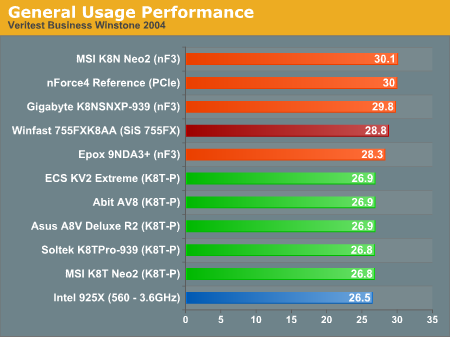
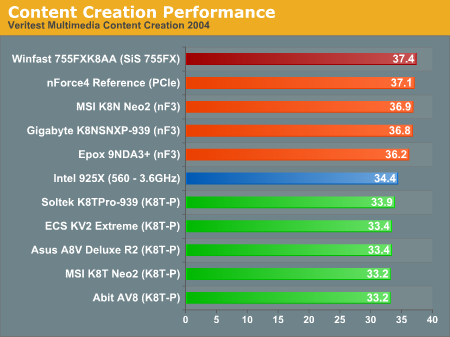
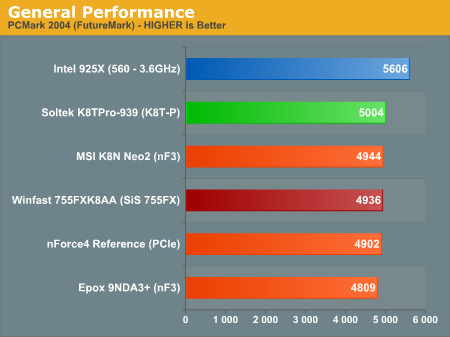
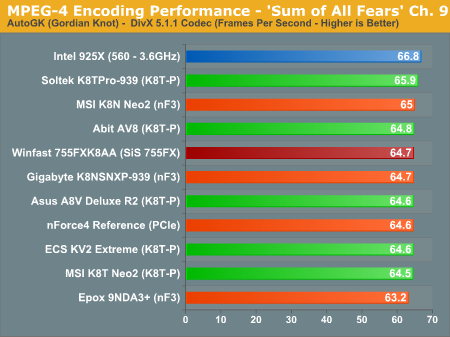
In past reviews, we had pointed out the fact that Winstone performance on the nForce3/nForce4 chipset was better than VIA chipset performance. The SiS755FX performs like nForce4 in Winstones, landing at or near the top of both charts in performance. AutoGK and PCMark 2004 performance is competitive with other Socket 939 boards.
DirectX 9 Gaming Performance
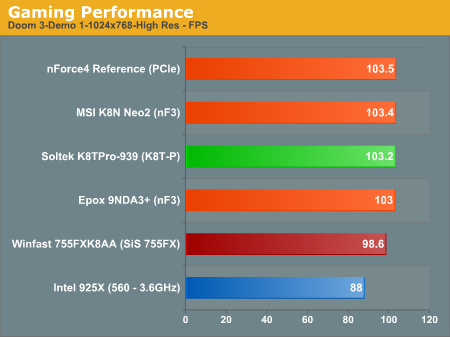
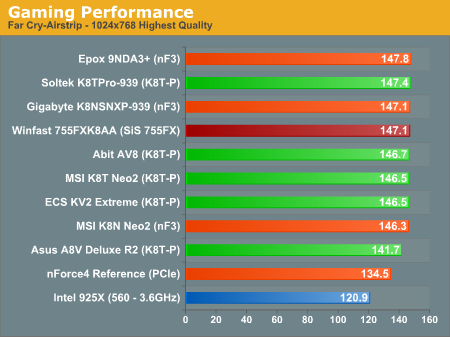
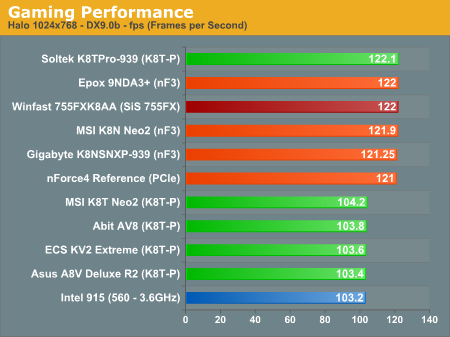
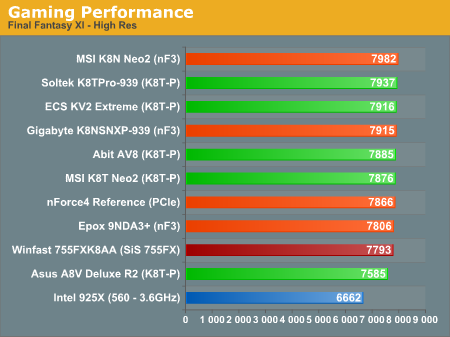
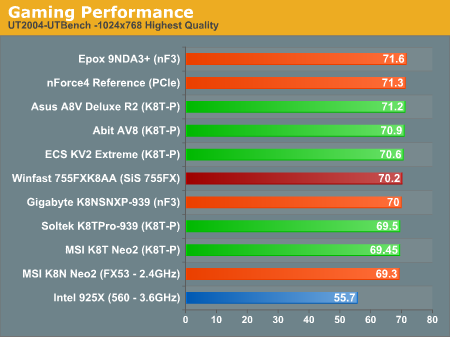
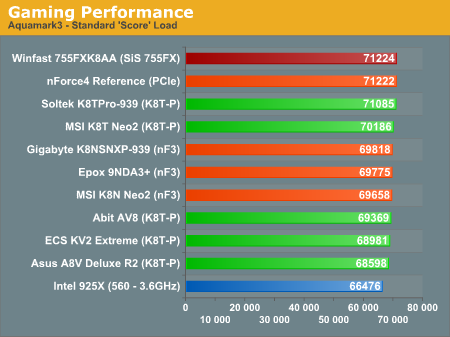
At first glance, the SiS 755FX looks to be an outstanding performer in Direct X 9 gaming. The Winfast was the top performer among all the 939 boards that we have tested in Aquamark 3. It was also a top performer in Halo and Far Cry. This outstanding performance in most DX9 games is offset by below average results in Final Fantasy and Doom 3 compared to other 939 boards. Overall, we consider the 755FX to be one of the best 939 chipsets that we have tested for DX9 gaming.
DirectX 8 & OpenGL Gaming Performance
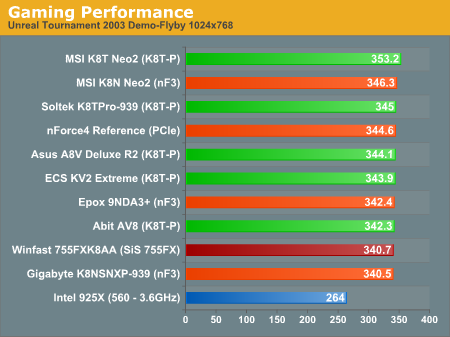
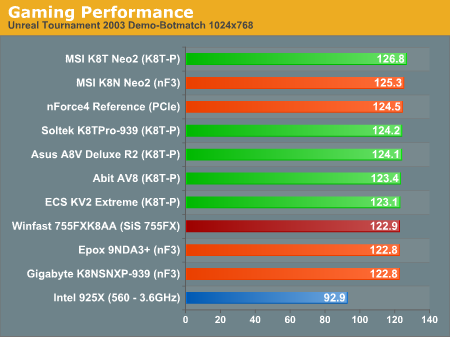
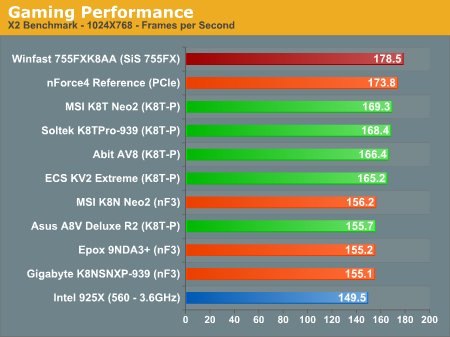
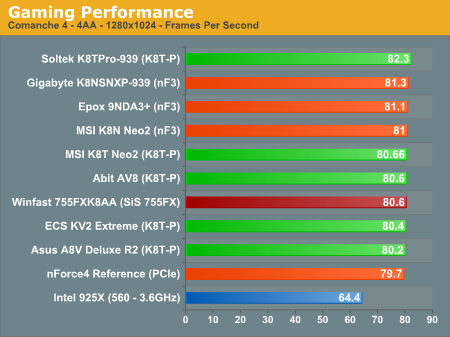
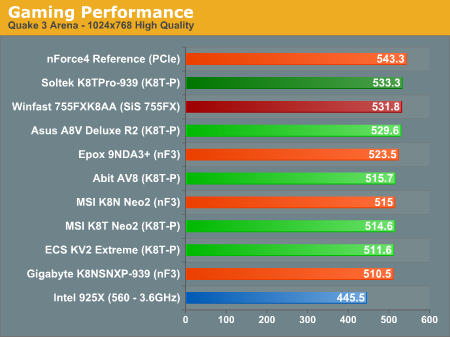
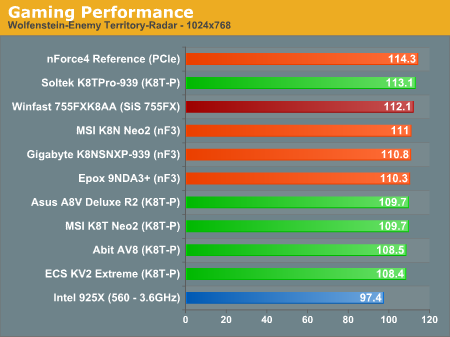
The Winfast is a top performer in X2, Quake 3 and Wolfenstein-Enemy Territory. Offsetting this is average to below average performance in UT2003 and Comanche 4. Overall, performance in older DX8.1 and OpenGL games is above average compared to other Socket 939 chipsets.
Workstation Performance
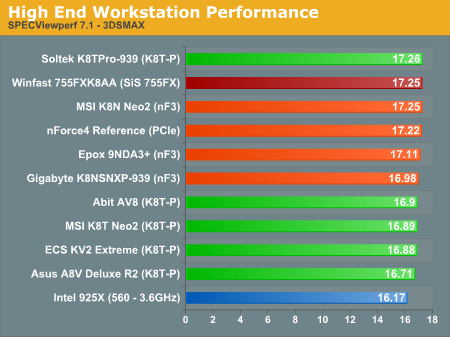
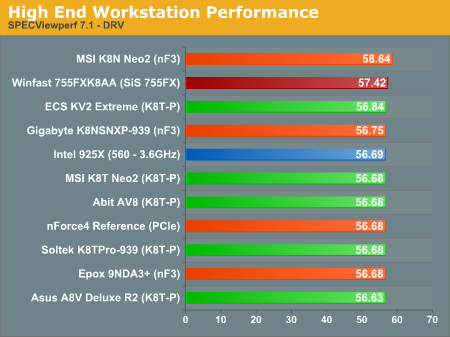
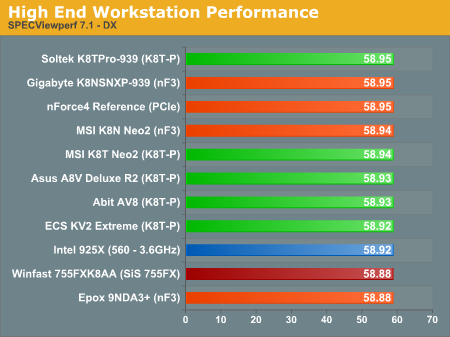
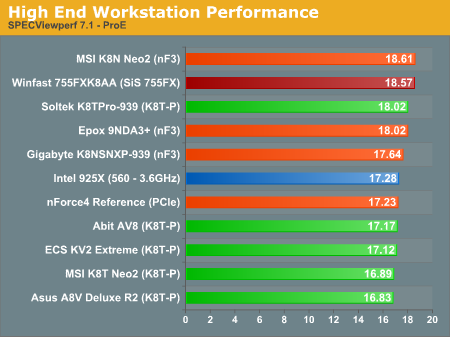
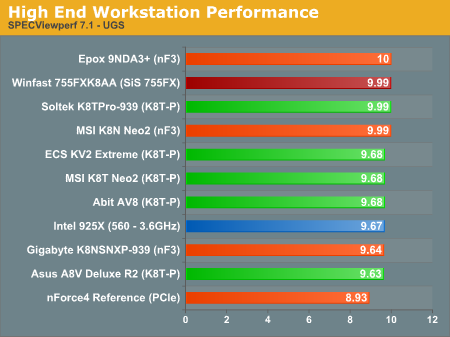
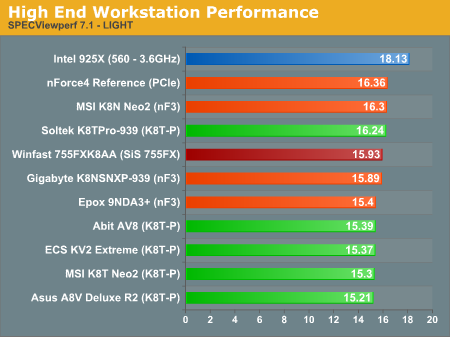
Workstation benchmark performance for the Winfast 755FX is above average among 939 chipsets. For a board that sells for such a reasonable price, this level of performance in Workstation benchmarks is really excellent.
Our Take
If we look at this review as an evaluation of the SiS 755FX chipset, we have to say that we remain impressed with what SiS has done in the Athlon 64 chipset market. In the transition to Socket 939 and dual-channel memory, SiS has kept the fast performance that made the 755 chipset a standout. This is basically the same chipset that we tested almost a year ago and it still holds its own against the latest nForce 4 and updated VIA chipsets. It seems as of late that our tests of SiS chipsets leave us wondering what they could really do in a top-of-the-line motherboard design, but we will likely have to keep wondering, since we do not know of any SiS boards in the works right now except those geared for value price points.That should take absolutely nothing away from the excellent performance of the Winfast 755FXK8AA. The board is very fast at stock speeds. When you consider it is designed to sell for less than $100, we are impressed at the very complete feature set and excellent layout that Foxconn have managed to build into this motherboard. You don't even expect to be able to buy a top performing 939 motherboard for $100, let alone a board with Gigabit LAN, Firewire and 8-channel on-board audio. Foxconn has done a very good job of delivering value in the Winfast, and you won't feel like you have compromised on features at all if you choose the 755FXK8AA for your new 939 Athlon 64 system.
For the capabilities it does have in overclocking, the Winfast is rock solid. It can run at 233 all day long without any issues. The CPU voltages with both + and - ranges also allow the board to be used for both modest overclocking as well as modest underclocking. Some users do underclock to reduce noise and heat to the lowest possible levels and it is not always easy to find a board that will underclock. The Foxconn will fit those users very well.
Disappointment comes into play in considering overclocking and what might have been with the Winfast. The lack of a clock generator that supports more than 233 and the missing memory voltage adjustments limit a board that could have been so much more. The 755FX is so good to 233 that we are severely disappointed that it doesn't have the stuff to let us see where the SiS755FX chipset can really go. There is also the frustration that this is perilously close to the magic sub $100 Socket 939 board that everyone is looking for. A different clock generator, memory voltage adjustments, a BIOS fix for 4 DS dimms, and a bit more attention to what the Athlon 64 enthusiast is looking for would have made this board a huge sales success.
As it is, the Foxconn is still easy to recommend. It is solid, fast at stock speeds, and filled with the features most users want. It is an incredible bargain when the selling price is considered. You can easily reach 233 even with the limitations, which make it a decent match to a 90nm 3500+ or faster processors for overclocking. That is because you can reach near 2.6GHz with the 3500+ combination even with the 233 limitation. For overclockers looking to push the 3000+ or 3200+ to 2.6 to 2.8GHz, however, you need to look elsewhere as 233 is just not enough. It is also not a board we would choose if we planned to run 4 DS dimms, but we suspect Foxconn could fix the 4 DS dimm issue with a BIOS update that offered 200 as a memory speed choice.
If you're not an overclocker or only have modest needs for overclocking, then by all means, go for the Winfast 755FXK8AA. It is a fast performer and you will not be disappointed. If we could just get past what might have been . . .







